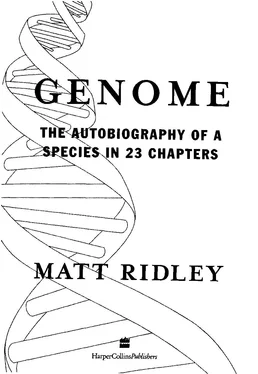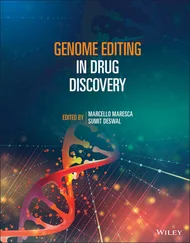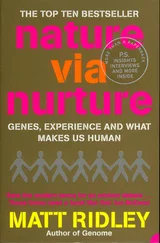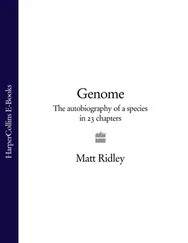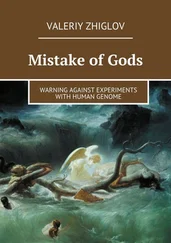Genome - Matt Ridley
Здесь есть возможность читать онлайн «Genome - Matt Ridley» — ознакомительный отрывок электронной книги совершенно бесплатно, а после прочтения отрывка купить полную версию. В некоторых случаях можно слушать аудио, скачать через торрент в формате fb2 и присутствует краткое содержание. Жанр: Старинная литература, на английском языке. Описание произведения, (предисловие) а так же отзывы посетителей доступны на портале библиотеки ЛибКат.
- Название:Matt Ridley
- Автор:
- Жанр:
- Год:неизвестен
- ISBN:нет данных
- Рейтинг книги:5 / 5. Голосов: 1
-
Избранное:Добавить в избранное
- Отзывы:
-
Ваша оценка:
- 100
- 1
- 2
- 3
- 4
- 5
Matt Ridley: краткое содержание, описание и аннотация
Предлагаем к чтению аннотацию, описание, краткое содержание или предисловие (зависит от того, что написал сам автор книги «Matt Ridley»). Если вы не нашли необходимую информацию о книге — напишите в комментариях, мы постараемся отыскать её.
Matt Ridley — читать онлайн ознакомительный отрывок
Ниже представлен текст книги, разбитый по страницам. Система сохранения места последней прочитанной страницы, позволяет с удобством читать онлайн бесплатно книгу «Matt Ridley», без необходимости каждый раз заново искать на чём Вы остановились. Поставьте закладку, и сможете в любой момент перейти на страницу, на которой закончили чтение.
Интервал:
Закладка:
trillion cells. Because some cells cease doubling early and others continue, many tissues are created by more than fifty doublings, and because some tissues continue repairing themselves throughout life, certain cell lines may have doubled several hundred times during a long life. That means their chromosomes have been 'photocopied'
several hundred times, enough to blur the message they contain.
Yet fifty billion copyings since the dawn of life did not blur the genes you inherited. What is the difference?
Part of the answer lies on chromosome 14, in the shape of a gene called TEP1. The product of TEP1 is a protein, which forms part of a most unusual little biochemical machine called telomerase. Lack of telomerase causes, to put it bluntly, senescence. Addition of telomerase turns certain cells immortal.
The story starts with a chance observation in 1972 by James Watson, D N A ' s co-discoverer. Watson noticed that the biochemical machines that copy D N A , called polymerases, cannot start at the very tip of a D N A strand. They need to start several 'words' into the text. Therefore the text gets a little shorter every time it is I M M O R T A L I T Y 1 9 7
duplicated. Imagine a photocopier that makes perfect copies of your text but always starts with the second line of each page and ends with the penultimate line. The way to cope with such a maddening machine would be to start and end each page with a line of repeated nonsense that you do not mind losing. This is exactly what chromosomes do. Each chromosome is just a giant, supercoiled, foot-long D N A molecule, so it can all be copied except the very tip of each end. And at the end of the chromosome there occurs a repeated stretch of meaningless 'text': the 'word' T T A G G G repeated again and again about two thousand times. This stretch of terminal tedium is known as a telomere. Its presence enables the DNA-copying devices to get started without cutting short any sense-containing
'text'. Like an aglet, the little plastic bit on the end of a shoelace, it stops the end of the chromosome from fraying.
But every time the chromosome is copied, a little bit of the telomere is left off. After a few hundred copyings, the chromosome is getting so short at the end that meaningful genes are in danger of being left off. In your body the telomeres are shortening at the rate of about thirty-one 'letters' a year - more in some tissues. That is why cells grow old and cease to thrive beyond a certain age. It may be why bodies, too, grow old — though there is fierce disagreement on this point. In an eighty-year-old person, telomeres are on average about five-eighths as long as they were at birth.1
The reason that genes do not get left off in egg cells and sperm cells, the direct ancestors of the next generation, is the presence of telomerase, whose job is to repair the frayed ends of chromosomes, re-lengthening the telomeres. Telomerase, discovered in 1984 by Carol Greider and Elizabeth Blackburn, is a curious beast. It contains R N A , which it uses as a template from which to rebuild telomeres, and its protein component bears a striking resemblance to reverse transcriptase, the enzyme that makes retroviruses and transposons multiply within the genome (see the chapter on chromosome 8).
Some think it is the ancestor of all retroviruses and transposons, the original inventor of R N A - t o - D N A transcription. Some think that because it uses R N A , it is a relic of the ancient R N A world.
1 9 8 G E N O M E
In this context, note that the 'phrase' T T A G G G , which is repeated a few thousand times in each telomere, is exactly the same in the telomeres of all mammals. Indeed, it is the same in most animals, and even in protozoans, such as the trypanosome that causes sleeping sickness, and in fungi such as Neurospora. In plants the phrase has an extra T at the beginning: T T T A G G G . The similarity is too close to be coincidental. Telomerase has been around since the dawn of life, it seems, and has used almost the same R N A template in all descendants. Curiously, however, the ciliate protozoans — busy microscopic creatures covered in self-propelling fur - stand out as having a somewhat different phrase repeated in their telomeres, usually T T T T G G G G o r T T G G G G . The ciliates, you may remember, are the organisms that most frequently diverge from the otherwise-universal genetic code. More and more evidence points to the conclusion that the ciliates are peculiar creatures that do not fit easily into the files of life. It is my personal gut feeling that we will one day conclude that they spring from the very root of the tree of life before even the bacteria evolved, that they are, in effect, living fossils of the daughters of Luca herself, the last universal common ancestor of all living things. But I admit this is a wild surmise - and a digression.3
Perhaps ironically, the complete telomerase machine has been isolated only in ciliates, not in human beings. We do not yet know for sure what proteins are brought together to make up human telomerase and it may prove very different from that in ciliates.
Some sceptics refer to telomerase as 'that mythical enzyme', because it is so hard to find in human cells. In ciliates, which keep their working genes in thousands of tiny chromosomes each capped with two telomeres, telomerase is much easier to find. But by searching a library of mouse D N A for sequences that resemble those used in the ciliate telomerase, a group of Canadian scientists found a mouse gene that resembled one of the ciliate genes; they then quickly found a human gene that matched the mouse gene. A team of Japanese scientists mapped the gene to chromosome 14; it produces a protein with the grand, if uncertain title of telomerase-associated I M M O R T A L I T Y 1 9 9
protein 1, or T E P 1 . But it looks as if this protein, although a vital ingredient of telomerase, is not the bit that does the actual reverse transcription to repair the ends of chromosomes. A better candidate for that function has since been found but, as of this writing, its genetic location is still uncertain.4
Between them, these telomerase genes are as close as we may get to finding the 'genes for youth'. Telomerase seems to behave like the elixir of eternal life for cells. Geron Corporation, a company devoted to telomerase research, was founded by the scientist who first showed that telomeres shrink in dividing cells, Cal Harley.
Geron hit the headlines in August 1997 for cloning part of telomerase. Its share price promptly doubled, not so much on the hope that it could give us eternal youth as on the prospect of making anti-cancer drugs: tumours require telomerase to keep them growing.
But Geron went on to immortalise cells with telomerase. In one experiment, Geron scientists took two cell types grown in the laboratory, both of which lacked natural telomerase, and equipped them with a gene for telomerase. The cells continued dividing, vigorous and youthful, far beyond the point where they would normally senesce and die. At the time the result was published the cells that had had the telomerase gene introduced had exceeded their expected lifespan by more than twenty doublings, and they showed no sign of slowing down.5
In normal human development, the genes that make telomerase are switched off in all but a few tissues of the developing embryo.
The effect of this switching off of telomerase has been likened to the setting of a stopwatch. From that moment the telomeres count the number of divisions in each cell line and at a certain point they reach their limit and call a halt. Germ cells never start the stopwatch
- they never switch off the telomerase genes. Malignant tumour cells switch the genes back on. Mouse cells in which one of the telomerase genes has been artificially 'knocked out' have progressively shorter telomeres.6
Читать дальшеИнтервал:
Закладка:
Похожие книги на «Matt Ridley»
Представляем Вашему вниманию похожие книги на «Matt Ridley» списком для выбора. Мы отобрали схожую по названию и смыслу литературу в надежде предоставить читателям больше вариантов отыскать новые, интересные, ещё непрочитанные произведения.
Обсуждение, отзывы о книге «Matt Ridley» и просто собственные мнения читателей. Оставьте ваши комментарии, напишите, что Вы думаете о произведении, его смысле или главных героях. Укажите что конкретно понравилось, а что нет, и почему Вы так считаете.
